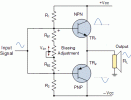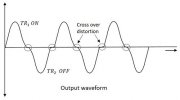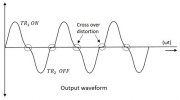Dear rsjaurr.
My post appears to have riled you.... My post and all its content was made in Full seriousness, I was Not being funny.... Just technically factual

Your questions demand putting much pen to paper, if they are to be fully clarified.
In this post, I will try to be brief. If a deeper technical interest is there, I will elaborate further, in subsequent posts.
There is often a incomplete understanding of what is Class A Bias (in the interest of Brevity, will restrict this discussion to the Output stage of an Audio Power Amplifier.
The Diagram below shows a very simplified "Push Pull" Output stage for an Audio Power amplifier.
Depending on the biasing Adjustment, the SAME output stage circuit can be operated in Class A, Class B Or Class AB.
View attachment 58116
TR1 & TR2 are transistors. Consider them to be like Taps in lines delivering water (actually power) to the Speaker.
The input signal consists of a Top (Positive) half and a lower (Negative) Half.
In a Class B Amplifier, TR-1 delivers (Pushes out) the Positive Half and then shuts off.
TR-2 then delivers (Pulls in ) the Negative Half and shuts off.
Note: There is ZERO Current flowing in TR-1 & TR-2 when there is no signal.
So
NO HEAT is produced in a Class B amplifier when there is no signal / music
The 2 Halves will never mesh perfectly with each other in a Class B amplifier, since TR-1 & TR-2 Take a certain finite time to switch on and off. The Resultant is a signal shown below, delivered to the Speaker.
View attachment 58118
The result is distortion in the Crossover Region where TR-1 stops and TR-2 begins. This is called "Cross Over Distortion"
CLASS AB AMPLIFIER
In an effort to reduce / minimise (NOT ELIMINATE) the Cross Over Distortion, TR-1 & TR-2 are forced to carry a small current (approx 20 to 50 Milli amperes) all the time, so that hopefully, TR-1 & TR-2 never fully switch off and cause Crossover distortion. This is called a Class AB Amplifier.
A Class AB amplifier will produce some (a little) heat when there is no signal. As the signal increases, TR-1 & TR-2 need to feed more power to the Speaker, and they will heat up.
CLASS A AMPLIFIER
To completely Eliminate Cross over distortion, TR-1 & TR-2 are made to Carry a little more than the FULL POWER (eg 200 Watts) at ALL TIMES, even when there is no signal.
Hence TR-1 & TR-2 need to waste (dissipate) the Class A amplifier's Full power, when there is no signal. This is the time when a True Class A amplifier runs the Hottest! (ie when there is no signal).
As the signal arrives, part of this Full Power (say 200 Watts) is diverted to the Speaker, and the balance power continues to be wasted in TR-1 & TR-2. When the Class A amplifier is delivering 200 Watts into the speaker, it will waste / dissipate very little power in TR-1 & TR-2 since all 200 Watts are being delivered to the speaker.
The Class A amp will Run the Coolest when it is delivering full power!
REAL WORLD EFFICIENCY OF AN AUDIO CLASS A AMPLIFIER
To ensure that TR-1 & TR-2 do not switch off when delivering 200 Watts power to the speakers, they are made to carry a Higher current that what is required by the speaker at 200 Watts. How much more ? That depends on the designer, and how keen he is to make his amplifier sound good with real world speakers. A speaker may be rated at 8 Ohms, but its actual impedance may typically vary from say 5 Ohms to 10 Ohms. To further complicate matters, the Speaker does NOT act like a simple resistor. It acts as a part capacitor at some frequencies and as a Part inductor at some frequencies! As a result, a speaker may demand 50% more current at some frequencies, than what a simple calculation will show, for an 8 Ohm resistor as a speaker. A Great Class A amplifier will be able to drive such demanding speakers. So good the Class A amplifier may be made to carry 50% more current than what a simple calculation will indicate. THAT lowers the Efficiency of the Class A amplifier to well below that of the theoretical 50% that you have quoted.
Now
there is still the less than 100% efficiency of the Power Supply of the amp to be factored in. The Transformer and Rectifier could operate at 85% efficiency, even if a Regulated Power Supply is not used. If a regulated Power supply is used, efficiency will fall still further

, ie even more heat will be generated!
To roughly summarise, let us assume typical efficiencies:
45% efficiency (instead of the theoritical 50%) for the Class A Output Stage (keep some extra current in the stage so that the transistors dont 'bottom out' when delivering full output.
30% extra current for demanding speaker loads ie 30% extra power or 70% efficiency
85% efficiency for the Transformer and power supply
The result is: 0.45 x 0.7 x .85 = 0.267 or 27.7% efficiency, ie the good, Genuine Class A amplifier will draw from the mains, 4 TIMES its Max output to the speakers...
PER CHANNEL.
That is how a 200Watt Class A Audio Amplifier, Honestly and properly designed and specified will draw 1,600 Watts (approx) from the mains.
This is clearly exorbitant, and many Class A amps cut Deep corners, while trying to maintain their Class A Hype.
The short cuts are:
* Provide ONLY for enough Class A current into a resistive load.
* Provide ONLY enough Class A Current into an 8 Ohm Load (4 Ohm loads will make the amp run out of steam, demanding Double the current)
* Provide Only enough Class A Current for say 10% of the amplifier's rated power into 8 Ohms (eg enough current for 20 Watts Class A into 8 ohms resistive, in the case of an amp specified as "200 Watt Class A Amplifier per Channel".)
Each of the above shortcuts results in Non Class A operation for atleast some part of the amplifier's operation..... But Marketing Hype is maintained.
The above discussion is a bit technical.
If you want a not technical litmus test, if a Class A amplifier is Not running Very Hot.... Corners have been cut, and you do not have the best engineered Class A amplifier.
P.S: How hot is "Very Hot" ? Generally 65 deg C is "Too Hot To Touch for 10 seconds" This is also a temperature when Electronics begin to deteriorate rapidly, or causes the onset of 'thermal runaway" that will blow up the amplifier. An operating temperature of 45 to 50 deg C should not be exceeded for long term reliability.
 )
)



